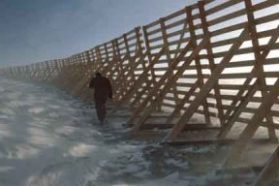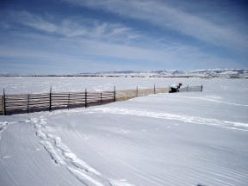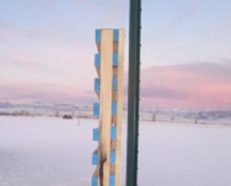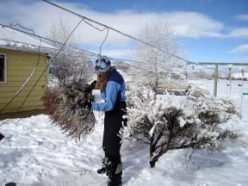Snow Traps
A prize-winning science fair project focuses on how snow fences create snowdrifts and increase water supply.
Share this:
- Share via email (Opens in new window) Email
- Click to share on Facebook (Opens in new window) Facebook
- Click to share on X (Opens in new window) X
- Click to share on Pinterest (Opens in new window) Pinterest
- Click to share on Reddit (Opens in new window) Reddit
- Share to Google Classroom (Opens in new window) Google Classroom
- Click to print (Opens in new window) Print
By Emily Sohn
Erica David was 11 years old when she discovered the scientific wonders of snow. Now, when even the biggest blizzards strike her area, she’d rather be out measuring wind gusts than sipping cocoa by a fire.
“Some kids call me crazy,” says Erica, a 16-year-old sophomore at Pinedale High School in Wyoming. “Days with 20-mile-per-hour winds are my favorite snow days.”
Erica has turned her love of snow into 5 years’ worth of science fair projects, with no end in sight. The work has earned her two trips to the Discovery Channel Young Scientist Challenge (DCYSC) for middle school science fair winners and two trips to the Intel International Science and Engineering Fair (ISEF), which features top high school science projects from around the world. Among other prizes, she won $5,000 at this year’s ISEF, held last month in Indianapolis.
 |
|
This type of snow fence, commonly found in Wyoming, is used to control drifting and blowing snow. Such fences can be up to 14 feet tall. |
| © Copyright 2006 Ronald D. Tabler. Reproduced with permission. |
Erica’s projects have dealt with the use of fences and shrubs to control blowing and drifting snow, particularly to deposit snow in suitable locations and to increase water supplies. Her research has shown that properly constructed fences can trap a significant amount of snow, a benefit for Wyoming and other places where water shortages are a major problem.
Drifting detergent
Erica has always liked playing in the snow, but an encounter with a snow scientist when she was in the sixth grade taught her that snow is more than just fun. Studying snow can lead to useful things, such as methods for shielding highways from drifting snow and for easing droughts.
In Wyoming, for example, the highway department erects tall snow fences to help keep roads clear of snowdrifts. These fences, up to 14 feet tall, consist of horizontal boards mounted on posts, with spaces between the boards. As the wind carries snow over and through such a fence, it slows down and deposits snow in a wide drift behind the fence.
 |
|
SNK reporter Emily Sohn (left) interviews Erica David about her project at the 2006 Intel International Science and Engineering Fair, held in Indianapolis. |
| Photo by V. Miller |
Erica’s first challenge was to find a household product that she could use to imitate drifting snow. Her tests showed that Cascade dish detergent works best. “It had static,” she says, “so the grains stuck to each other.”
This project brought her to Washington, D.C., as a DCYSC finalist in October 2002. There, with video cameras running and lots of media attention, she learned how important it is for a scientist to know how to communicate.
The next year, when Erica was in the seventh grade, she looked at ways in which the standard Wyoming snow-fence design might be improved.
Working in her garage with a fan, wind tunnel, and dish detergent, Erica tested scale models of six fence designs. In three of the designs, the boards had different spacings. In the other three, the boards had the same spacing but different thicknesses. She discovered that fences made with extrathick boards catch more snow than fences made with standard-size boards do (see “Effect of Snow Fences on Snowdrifts”).
 |
|
The horizontal boards in these three model fences have different spacings. |
| Photo by V. Miller |
At the 2003 DCYSC competition, Erica won a week at Vanderbilt University’s Girls and Science Camp.
Because she had won an award in 2003, Erica wasn’t eligible to enter DCYSC in 2004. But she continued her research anyway. This time, she studied the effect of snow packing on the amount of snow that vaporized (sublimed), thereby reducing the amount of snow available later for melting and increasing the water supply. Dense snow piles with small surface areas last longest, she found.
Drought relief
Last year, Erica scaled up her fence models to test how they would do outdoors in real snow. With her father’s help, she built three 3-foot-tall snow fences, each one with boards of a different thickness. When the weather grew snowy and blustery, she measured wind speeds behind each structure.
 |
|
Erica measures snow depth behind one of her test snow fences. |
| Courtesy of E. David |
Confirming her earlier observations with small models, Erica found that a fence with thicker boards slowed the wind and trapped more snow than a fence made with thinner boards did. The fence with the thickest boards created a tall, narrow snowdrift close to the fence that lasted a long time.
Because it’s possible to use rows of trees or shrubs instead of fences to control snow drifting, Erica also started investigating how effective the branches of different trees are for intercepting snow. She focused on the role that the moisture content of fir and pine branches plays in water conservation.
Erica oven-dried pine and fir branches to three levels of moisture content. “All of our food smelled like pine for a long time,” she says. To her surprise, Erica found that among firs, the driest branches are stiffest at subzero temperatures, but among pines, the moistest branches are stiffest.
Under drought conditions, she concluded, pines help conserve water by becoming more flexible when dry and depositing more snow on the ground.
These findings earned Erica a third-place prize (and $1,000 dollars) at last year’s ISEF, held in Phoenix, Ariz.
Improvements
Trapping and packing snow is a great strategy for conserving water, but building fences with thick boards is expensive. So, this year, Erica compared her original thick-board fence with some alternative designs.
 |
|
Erica’s studies showed that this “thick” fence caught more snow than did other test fences. This end view shows the 2-inch strip of wood separating the thin horizontal boards (blue ends) to create a gap. |
| Courtesy of E. David |
In one of these designs, she used two thin boards separated by a 2-inch gap in place of each thick board. The total thickness was still 4 inches, however. Erica’s experiments showed that this fence caught more snow and packed it more densely than did either a traditional fence or the previously tested thick fence.
Erica also investigated the potential use of sagebrush for snow interception and water conservation. Sagebrush is common throughout Wyoming and many other states.
 |
|
Erica collects intercepted snow from sagebrush samples to measure the snow’s mass and water content. |
| Courtesy of E. David |
As she had done previously for pine and fir, Erica measured the force needed to bend sagebrush branches at subzero temperatures. She discovered that the branches of sage plants become stiffer as the plants get older. This means that older plants hold more snow, increasing the amount of snow lost to sublimation and reducing the amount that becomes part of the snow pack on the ground.
Erica’s project, called “Boards and Branches—Year 5,” won a best-of-category award for environmental sciences at the 2006 ISEF. Her research on building fences and managing plants in a way that would let more water seep into the ground has attracted the attention of government agencies interested in developing strategies for reducing droughts.
Building fences
For next year’s project, Erica plans to build fences as tall as 14 feet and to test how well they work. Whether or not her prize-winning streak continues, she’s sure to keep uncovering more of nature’s snow secrets.
Erica also has advice for anyone inspired to tackle a science fair project. “If you have a passion, like animals or microbiology, go from there,” she says. “Allow yourself to be passionate. And have fun.”
Going Deeper:






